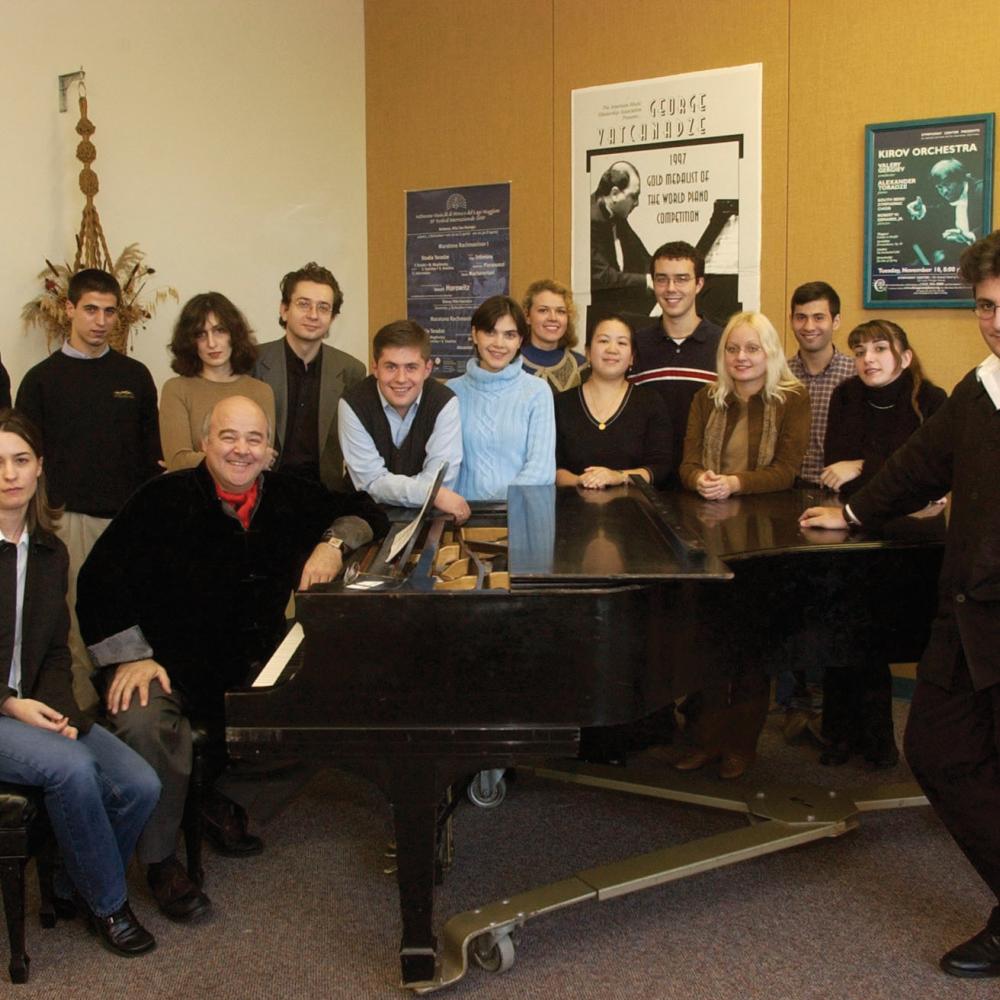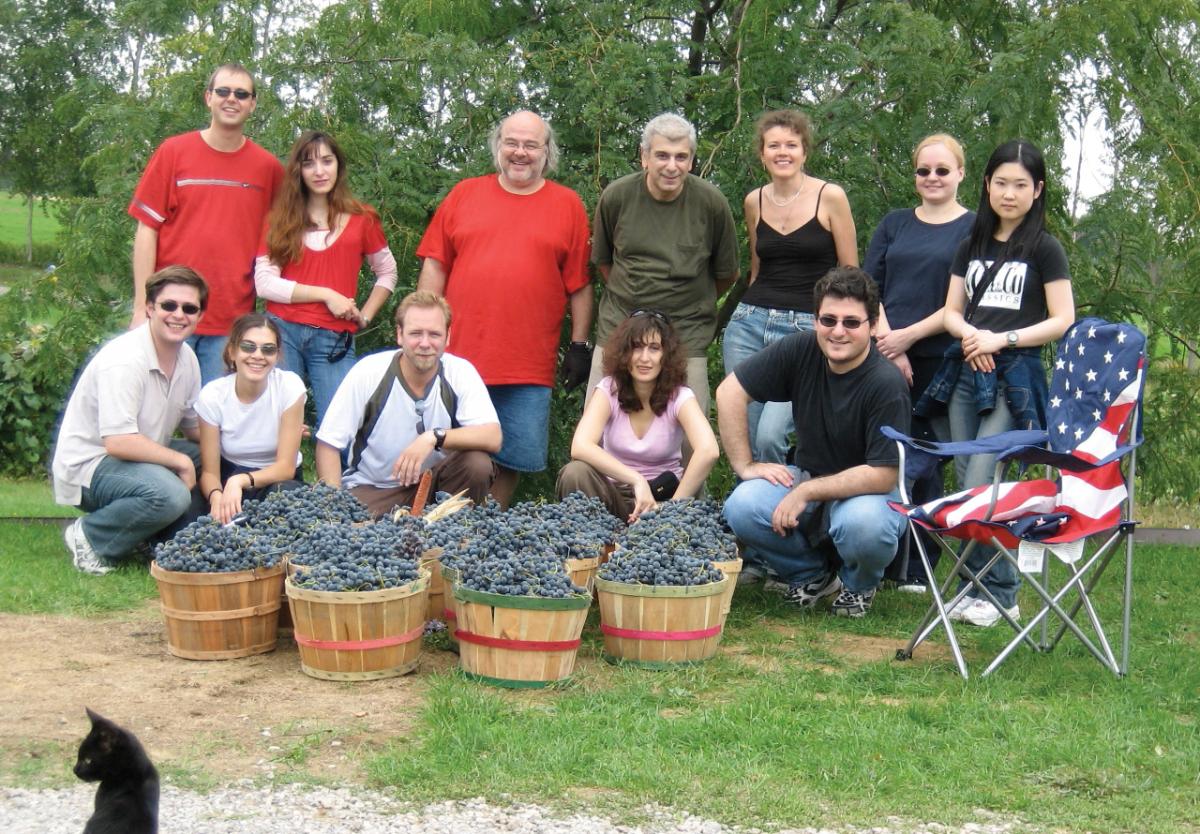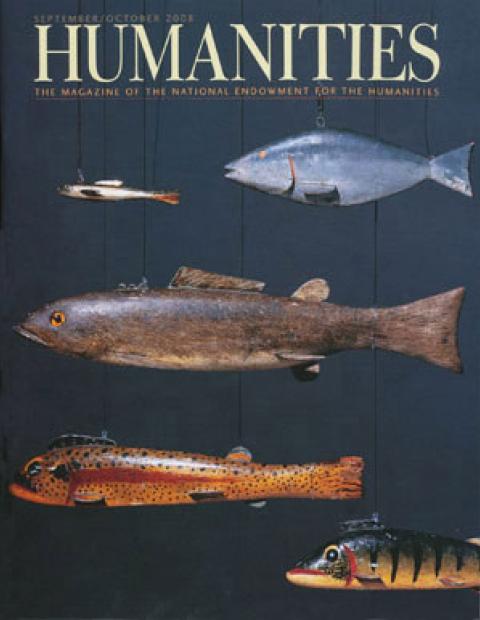During the first half of the twentieth century—decades of war and revolution—an “intellectual migration” relocated thousands of artists and thinkers to the United States, including some of Europe’s supreme actors, dancers, composers, and filmmakers. For them, America proved to be both a strange and opportune destination. A “foreign homeland” (Thomas Mann), it would frustrate and confuse, yet afford a clarity of understanding unencumbered by native habit and bias. However inadvertently, the condition of cultural exile would promote acute inquiries into the American experience. What impact did these famous newcomers have on American culture, and how did America affect them?
Exploring these questions in my book Artists in Exile, I found that, taken as a whole, twentieth-century American immigrants in the performing arts were not able to sustain a full growth curve upon relocating. Some lost their way entirely. Of those who did not, almost all enjoyed a more consummated European calling. The exceptions—the major old-world careers that accelerated in the New World—can be counted on the fingers of one hand: George Balanchine in dance, Americanizing classical ballet; Ernst Lubitsch in film, parlaying operetta wit into a prized Hollywood confection; the pianist Rudolf Serkin, a heroic American solo artist and relentless American pedagogue; the conductor Serge Koussevitzky, whose Tanglewood Festival became a New England laboratory for new American music. More typically, unreplantable old-world roots signified stunted cumulative growth. And yet, in every field the intellectual migration raised the bar; the arena was enlarged.
The final stirrings of cultural exchange in American exile—a postscript to my account—are to be found among post-Stalin defectors from the Soviet Union and its satellites. The most significant American-based careers include those of Milos Forman and Mikhail Baryshnikov. In Forman’s superb Hollywood production, One Flew Over the Cuckoo’s Nest (1975), the droll, affectionate, and painstaking observation of human behavior, typical of his Czech films, is applied to the inmates of an American insane asylum and so powers a reading of psychological subjugation informed by the director’s own experience of confinement and debasement in Communist Czechoslovakia. Baryshnikov escaped the Kirov’s Soviet traditionalism to work with a gamut of American choreographers—Alvin Ailey, Balanchine, Eliot Feld, Mark Morris, Jerome Robbins, Twyla Tharp—in addition to joining Natalia Makarova and Rudolf Nureyev in impressing the full-length Russian ballet classics upon American audiences.
My close friends happen to include another Soviet defector: the pianist Alexander Toradze. Lexo is Georgian, born in Tblisi in 1952. His father was a leading Georgian composer. His mother was an actress. Groomed by the Soviet system, he entered Tblisi’s central music school at six and first played with orchestra at nine. He proceeded to the Moscow Conservatory at nineteen to study with Yakov Zak—then one of the great names of Russian pianism, after Sviatoslav Richter and Emil Gilels. When Zak proved unsupportive, Toradze left him—for a young Soviet artist, a bold and controversial move—for Boris Zemliansky, then Lev Naumov: intimate and intense relationships. In 1976 he was sent to compete in the Van Cliburn competition in Fort Worth and finished second. A flurry of Western dates ensued, but the Soviet invasion of Afghanistan soured cultural exchange with the United States. He festered. His fees were low. He felt suppressed as a Georgian. He was galled by the company of KGB “interpreters.” In 1977, he ran into Mstislav Rostropovich, a family friend, at a Paris airport. “When you go back, kiss the ground of our country,” Rostropovich told him. “But when are you going to do something?” On tour in Madrid with a Moscow orchestra in 1983, Toradze entered the American Embassy and requested refugee status. Within three months, he began a nine-city American tour with the Los Angeles Philharmonic.
When I first knew him in the late 1980s, Lexo lived in an apartment near Lincoln Center barely larger than his grand piano. The photographs on the lid were of his family; of himself with Van Cliburn, with Zubin Mehta, and with Esa-Pekka Salonen posed alongside a smiling, life-sized cutout of Ronald Reagan. A miniature basketball net was affixed to the bedroom door. A three-panel panorama of Tblisi sat privately in a closet. Toradze was a study in excess: he drank, he smoked, his weight fluctuated widely. As a pianist, he was loved or loathed. His personal life lacked stability. But his warmth and intellect, his gift for friendship and for original conversation, forged exceptional loyalties.
In 1990, he married an American girl, a fledgling pianist from Florida. In 1991, he accepted a piano professorship at Indiana University at South Bend—a place best-known for Notre Dame’s football team. Transplanted to northern Indiana, he proceeded to recreate the intense mentoring environment he had known in Moscow, as well as the communal social life he had known in Tblisi. To date, he has recruited more than seventy gifted young pianists, mainly from Russia and Georgia. They bond as a family, with Lexo the stern or soft surrogate father. They make music and party with indistinguishable relish. Lexo’s big house, on a suburban street without sidewalks, is their headquarters. Since separating from his wife in 1999, he has densely decorated the downstairs rooms with an assortment of American, Russian, and Georgian books and embellishments; the upstairs walls remain blank. The basement comprises a Ping-Pong room, a table-hockey room, and a Finnish sauna. The swimming pool outside is used in winter for furious ice baths in alternation with languorous sauna sittings.
South Bend is welcoming, comforting, and incongruous. As new Americans, the members of the Toradze community eat pizza, play basketball, and barbecue salmon in the backyard. They are addicted to such gadgets and amenities as giant TVs and state-of-the-art audio systems. They shop for steak and vodka in the early hours of the morning in vast twenty-four-hour food marts. Their social rituals are Russian or Georgian. So is their informed enthusiasm for jazz, which preceded their arrival. Though they do not attend the football games, Lexo’s excitement was boundless when he discovered that the forward pass was a South Bend invention.
To date, a dozen of them have become American citizens. They have found collegiate or university piano positions in Iowa, Ohio, Michigan, Massachusetts. A Toradze alumna accompanies the Notre Dame chorus. Another plays the organ in a South Bend church. Yet the group remains indissoluble. As the Toradze Piano Studio, Lexo and his students, past and present, form the basis of a unique touring ensemble, giving marathon programs of Shostakovich in Paris, Prokofiev in Edinburgh and St. Petersburg, Stravinsky in Rotterdam, Rachmaninoff in Salzburg. At Germany’s Ruhr Piano Festival, they offered an eight-hour Scriabin program. Instigated by Lexo, they have also launched ambitious forays into American repertoire: Gottschalk, Griffes, Farwell, Ives, Gershwin, Barber, Copland, Bernstein. At Italy’s Stresa festival, they explored “Dvořák and America.”
Toradze himself plays no American music. In his fifties, he alternates between Herculean gusts of energy and bouts of depressive calm. In the piano world, he remains a singular and confrontational artist. He insists on treating personal drama as a necessary aspect of interpretation. Teaching Beethoven’s Op. 109 Sonata on Japanese television a couple of years ago, he fearlessly applied to its three-movement design the story of Beethoven’s “immortal beloved.” He did not insist that others agree—only that personal meanings be discovered and enforced. His style is widely considered self-indulgent or revelatory.
He is a painstaking, if sporadic, worker who struggles to discipline his time. He acquires new repertoire slowly. Most of what he plays is Russian: Tchaikovsky, Rachmaninoff, Stravinsky, Shostakovich. His most indelible statement comes in Prokofiev’s Second Piano Concerto; interpolating darting swells and stabbing staccatos, writhing rubatos and colossal chordal onslaughts, he reinvents this music as a traumatic narrative of loss extrapolated from the dedication to Maksimilian Shmitgoff, a deceased friend of the composer. “The concerto is his friend’s life and funeral, the devastation Prokofiev experienced and his desire to turn the clock back,” Lexo explains. “At the start of the piano part Prokofiev writes ‘narrante’—he starts his story telling you about his beloved friend who died. He asks you to share his pain. The second theme shows the youngster’s playfulness; he remembers funny stories associated with him and elaborates on that. The cadenza is unique in all Prokofiev’s music; you will never find in the other concertos, or in any of the sonatas, such intense devastation. The climax of the cadenza is the entrance of the orchestra, which is itself an unusual thing. It says that you cannot grieve all by yourself—without sharing your sorrow, your pain, with other people. In Russia, and also in Georgia, death is a huge public event. Everyone comes to the funeral. It sounds so trivial to say these words, but this is such an honest description. I’m sure if you were to talk to Prokofiev, he never would be able to talk to you as sensitively as he speaks in his music here.”
Toradze believes that the loneliness of exile is useful to him. “I can’t just look at a score and think: Gosh, what a beautiful concerto; I’m going to make it just delicious. That doesn’t interest me. Composers, if they are expressing something, they do it because they cannot express it in other ways, because there is something they need to get out of their system. You don’t need to get out of your system pure happiness and joy. No, because it’s comfortable. So you need an element of discomfort, of irritation, certain spiritual urges that make you create this or that. That’s where our real differences are—in pain. Tolstoy, at the beginning of Anna Karenina, says: ‘All happy families resemble one another; each unhappy family is unhappy in its own way.’ So I have to find this element. I have to find two or three pages of pain. Then I use that, because I can associate with that, and elaborate. I can use my own experience. And fortunately, my own experience with pain is quite considerable.”
Toradze’s most frequent concerto partner is Valery Gergiev, whom he has known since their Moscow student days; he is a de facto member of Gergiev’s nonpareil Kirov ensemble, regularly touring Europe and America with the Kirov Orchestra. In 1991, he returned to Russia for the first time, to perform the second Prokofiev concerto with Gergiev. In 2005, he took the Toradze Studio on tour throughout Georgia, still the home of his mother and the site of his father’s grave, presiding over eighteen concerts of five and six hours each over the course of three weeks. His career remains European-based. With few exceptions, his friends are European, Russian, and Georgian.
Returning from abroad, Lexo will report copiously on the extraordinary musical public in Berlin, Budapest, Prague, or Tel Aviv. He permits himself rare outbursts of frustration with American cultural conditions. And South Bend can seem suffocating. Feelings of gratitude and friendship war with impatience and fatigue. There are other feelings less apparent to an American like myself. Lexo tells me:
“Very obviously, from the standpoint of nourishing cultural needs, South Bend may not be the ideal place for young artists to grow up. And it may not be true that we actually enjoy in this country all the ‘open society’ benefits that we’ve been told about. But for my generation—especially in Soviet Russia, at the Moscow Conservatory and also in Tblisi—this notion of American freedom is still powerful, and I’m sure it’s still powerful for the world at large. For my generation, even the musical aspect of freedom was symbolized by American jazz. We would stay up at night, years in a row, listening to the Voice of America at 12:15 a.m.: Willis Canover’s Jazz Hour. That was the talk of my generation and also of my parents’ generation. Of course you were in danger if you listened to these broadcasts. We often listened in a basement, where an older friend of ours had a very powerful shortwave receiver. That gave us a sense of freedom. Then life goes by and you actually get to this country and you carry this notion with you, even if you grow disappointed. Even if everyday life can be pretty harsh and difficult, still that cannot spoil the dream. It’s a dream so strongly associated with your youth that you’re just saturated with it. You can smell it, taste it, touch it. You can’t kill it and you don’t want to kill it. This dream is one of the things that bonds our group, even though we are now here in America. It’s a condition of hope associated with a faraway place. It’s actually a dream stronger than any reality.”
On New Year’s Day 2006, a wedding was held at Lexo’s house—the fifth to take place within the Studio. The partying lasted for three days. Lexo was best man. A Studio pianist played Mendelssohn’s “Wedding March” for the newlyweds—after which Lexo’s older son, David, played “The Star-Spangled Banner” on his trumpet. The elaborate rituals of male fellowship—kissing and toasting and drinking and toasting some more—honored centuries of Georgian tradition passed from father to son. The American guests, a minority, seemed to me a welcome but marginal presence. Lexo felt otherwise. He lifted his glass and said:
“Fourteen years ago, we came here to South Bend, where I had an opportunity to gather together this group of young friends and artists. The Martins, Rex and Alice, who endow my professorship, have been involved in practically every facet of the Studio. There is also Ernestine Raclin and her family, who constantly involve my students in their social life. And there are many others. But the most important support is the gradual support of the South Bend community over time. Indiana is a slow-to-react place. But the support is true support, sincere support, and when it gets moving it becomes something difficult to stop. It has nothing to do with loud showing off, with ‘Look what I’ve done.’ It’s down-to-earth support. From 1994 we started to travel a lot and we absorb very powerful experiences abroad. But then we return to the quiet and humble atmosphere of South Bend and it feels like home. This is where my boys were born. This is where some of us grew older and others of us grew up.
“When I asked David the other day what he would like to play at the wedding, he said, ‘The Star-Spangled Banner.’ I said, ‘OK. Fantastic.’ Why not? I think that even Balanchine would not have succeeded if he had remained in Russia. Not because he was Georgian, rather than Russian. Not because of politics either, but because the whole structure of Russian culture and tradition would not have permitted his innovations and free spirit. Something like that is also true of us. I mean, I can’t envision a group of performers in which 80 percent are not native-born succeeding anywhere else. Can you imagine something like this in Russia? In Germany? In France? You need an open, accepting environment, you need the attitude ‘Let it be.’ I feel this in South Bend. People trust and respect the way we do things. In fact, there are people here, including the Chancellor, who have not been in South Bend as long as we have. This is something that could only happen in America.”



